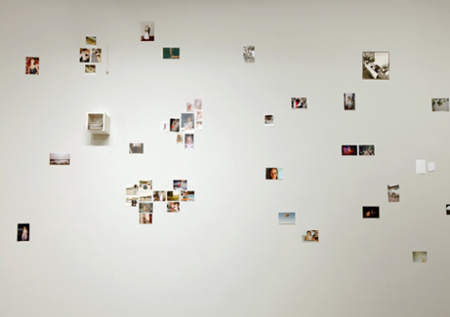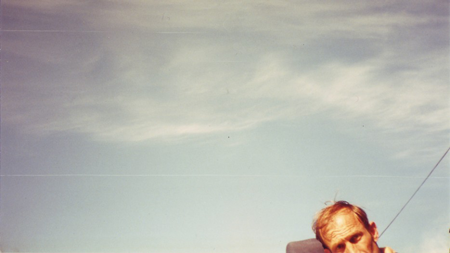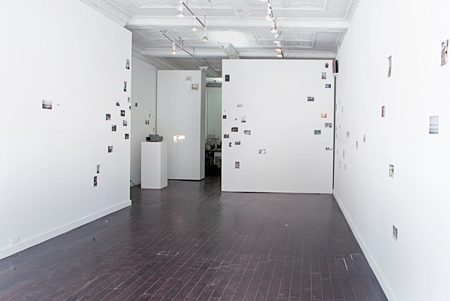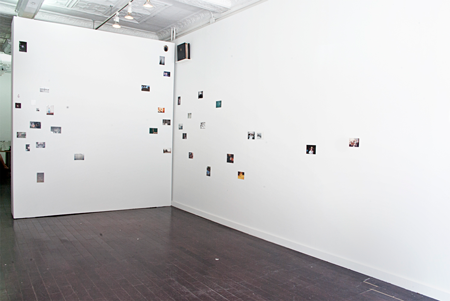Natasha Chaykowski
All images courtesy Jason Lazerus.
Studio-style portraits with a patina and palette that shines of decades past; ill-framed candid group photos; and unfocussed 4 x 6 snapshots of unremarkable landscapes, dreary skyscapes and abstract seascapes. This is some of the banal and ordinary photographic matter that comprises Jason Lazarus’s ongoing archival project, Too Hard To Keep (T.H.T.K.), currently on view at Gallery TPW in Toronto.

Jason Lazarus, T.H.T.K. (Toronto), Installation view Gallery TPW, 2013.
Started in 2010, the participatory archive now includes over four thousand photographs, slides, film canisters and other photographic material; it continues to grow as the project is exhibited in various iterations and receives further additions. Lazarus solicits donations from anyone who feels compelled by his call for photographs that are, eponymously, ‘too hard to keep’ yet also impossible for their owners to throw away. The call yields a breadth of content; some photographs are very obvious in their difficulty, as is the case with an image of a women with black eye, a photograph physically cut in half leaving a bride without her presumed groom, or a black-and-white image of a man in a casket, while others still are the stuff of the mundane: a beach, a baseball game, or someone sleeping sprawled on a bed in the formulaic confines of a hotel room. As Gabrielle Moser, curator-in-residence at TPW, succinctly suggests, ‘these are images typical of vernacular photography: that genre of innumerable, non-art photographs … that seem the product of both an everyday compulsion to make images as an aid-to-memory, and of dumb aesthetic luck made possible by the ubiquity of cheap and portable camera equipment’.[1]
Upon becoming part of the archive, photos are estranged from their original context, narrative, and meaning, embracing instead the role of anonymous arcane image. So while the photographs are afforded a sustained existence, they do so in a manner continuous with flea market letters to unknown lovers and lost diaries without names- the ruins of personal objects that continue to exist outside the proprietorship of their owners.

Jason Lazarus, T.H.T.K. (Toronto), Installation view Gallery TPW, 2013.
The most recent incarnation of T.H.T.K at Gallery TPW, takes for subject a selection of photographs, slides, and albums from the growing collection. Each iteration of the archive is a site-specific installation that responds to the architecture of the exhibition space. At TPW, photos are clustered thematically, oftentimes situated in unconventional locations like corners, close to the ceiling or near the floor, effectively thwarting expectations of traditional gallery installations. Additionally, several of the images are displayed with their photographic surface facing the wall, thus denying information twice over: once in the form of the photograph’s history and the narrative that accompanies its perceived difficulty and again in the denial of access to its actual pictorial data. Such photographs are hidden as their original owners stipulated that their donation remain ‘private’.
Perhaps the most affective element of this collection is its consistent denial of narrative information. Upon first looking at the photographs, I found myself wondering if the child in a cluster of portraits had passed away? If the couple in the series of slides had broken up? And if those abstract seascapes were too hard to keep as they recalled a home long gone and far away? This impulse to ascribe narrative information from the dislodged photos can be described as a sort of incomplete gestalt; the dissonance that arises from an unfinished story, in this case one of implicit loss or trauma, prompts the mind to fill in the gaps with personal or biographical details that satisfy the urge for completeness and fulfill the desire to know.
In addition to the photographs’ estrangement from their associated narratives, T.H.T.K implores questions regarding the materiality of photos, and the meaning assigned to such physically flimsy entities. How do memories become physical in the form of the photo? And how does relinquishing ownership of a photograph affect the painful memory bestowed upon it? The T.H.T.K. archive queries the means by which memories are made physical, suggesting that at least some part of a memory resides in the physical things that evoke it.

Jason Lazarus, T.H.T.K. (Toronto), Installation view Gallery TPW, 2013.
His stewardship of T.H.T.K. renders Lazarus as a collector, archivist and curator: roles embraced by artists in the spirit of a post-medium practice. The artist, however, is afforded the opportunity to blur the disciplinary boundaries of collector, archivist, and curator respectively, under the auspices of artistic praxis. As a collector for example, Lazarus, rather than single-mindedly seeking a prized object instead allows others to donate and participate in the collecting process, thereby re-situating the authority of the collector, a position firmly rooted in colonial and patriarchal structures, from a single privileged individual to a democratized collective.[2]
Moreover, Lazarus’s T.H.T.K. is an archive of discarded, no longer wanted objects, placing it at odds with the usual purposefulness with which archival collecting is compelled. As such, this project follows in a vein similar to that of Ilya Kabakov’s The Man Who Never Threw Anything Away (1977) wherein authoritative archival hierarchies are broken down. Kabakov’s installation is a dizzying abundance of bits of paper, receipts, memos, postcards, and photographs, among other things, meticulously labeled, organized, and archived. Here dull detritus and quotidian refuse become the stuff of value and preservation and, “comprise the single uninterrupted fabric of an entire life”.[3] Lazarus’s archive, rather than the fabric of an entire life, is the fabric of multiple lives, fragmented and then sown together by a mutual relinquishing of objects standing in for difficult memories. And while his collection is certainly not trash, the impetus to reassign value to articles of seeming banality engenders a transgression of traditional archival ontology.

Jason Lazarus, T.H.T.K. (Toronto), Installation view Gallery TPW, 2013.
The ontological status of the curator is perhaps even less stable than that of the archive. Lazarus’s employment of curatorial reasoning collapses the defined categories of curator and artist respectively, in another instance of transgressive post-medium practice. Of the four thousand odd artifacts in T.H.T.K., he is required to select a small number of photographic objects to exhibit in the project’s various incarnations. Such decisions, under the requirements of site-specificity, seem to be made based upon his knowledge of the collection, the character of his aesthetic preferences and the physical demands of the exhibition space.[4] Instead of relying on traditional curatorial techniques akin to connoisseurship, the project could perhaps benefit were the artist to employ a more avant-garde or progressive curatorial method.
In The Accidental Exhibition: Chance as Curatorial Critique and Opportunity, Leigh Markopoulous outlines several instances of curatorial strategies that employ chance operations in an effort to critique the, “exerting [of] undue authorial dominance over the exhibition format” that curators have assumed.[5] Markopoulous argues that such alternative strategies in curating find their roots in the employment of chance in artistic movements akin to Dada and Fluxus, and works by artists like John Cage. Here we see a reversal in progressive direction with Lazarus, who, situated as an artist, is regressing to antiquated forms curatorial authority. Were the selection process dictated by random selection, contingent operations or chance-based assignment, rather than subjective assertion, T.H.T.K. would be rendered further democratized in its exhibition format.

Jason Lazarus, T.H.T.K. (Toronto), Installation view Gallery TPW, 2013.
While the politics of exhibition practice and the specific processes of the project prove to be interesting sites of interrogation, T.H.T.K. is ultimately an instance of inciting productive looking within the viewer, troubling the assumptions of where the ‘too hard’ lies with these images. As Moser says in her curatorial essay, “… the difficulty resides in the viewer: in the frustration we feel in being unable to pin down the meaning of an image, and the discomfort that arises out of this ambiguity”.[6] The sum of these photographic parts will never achieve a whole: a whole narrative, picture, story, nor a complete understanding. In this way Too Hard To Keep mirrors the unfixed, ever-changing and incomplete nature of difficult memories and our irresolute relationship with them.
[1] Moser, Gabrielle. ‘Jason Lazarus- T.H.T.K. (Toronto)’. Gallery TPW, 2013, 2.
[2] Moser notes in her curatorial essay that while the process reads as democratized, the prevailing subjects of the archive are normatively white and middle class. The artist has suggested that perhaps this is due to a flaw in his dissemination of the call for submission.
[3] Kabakov, Ilya. ‘The Man Who Never Threw Anything Away’ in Groys, Boris, David A. Ross & Iwona Blazwick (eds). Ilya Kabakov (London: Phaidon Press, 1998), 99- 103. 102.
[4] ‘No Looking After the Internet’ discussion, Gallery TPW, July 30, 3013.
[5] Markopoulous, Leigh. ‘The Accidental Exhibition: Chance as Curatorial Critique and Opportunity’, Journal of Curatorial Studies, 1:1, 2012, 7-24. 8-9.
Natasha Chaykowski is a writer, emerging curator and art history graduate student at York University. Recently, she co-curated the annual Emerging Artist Exhibition at InterAccess in Toronto and worked at the Canadian Pavilion for the 55th Venice Biennale, and is currently editorial assistant for the Journal of Curatorial Studies. Chaykowski’s writing has appeared in the Art & Science Journal, the Art Gallery of York University, esse: arts + opinions and the Journal of Curatorial Studies.